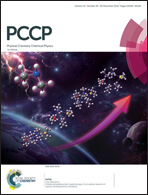Remarkable pressure-induced emission enhancement based on intermolecular charge transfer in halogen bond-driven dual-component co-crystals†
Abstract
A series of two-component co-crystals driven by I⋯N interactions based on the bipyridine (BIPY) chromophore with one among three different co-former building blocks, iodopentafluorobenzene (IPFB), 1,4-diiodotetrafluorobenzene (DITFB) and 1,3,5-trifluoro-2,4,6-triiodobenzene (IFB), were prepared and analysed via infared spectroscopy and single-crystal X-ray diffraction. By comparing the I⋯N distances in the co-crystal structures, we found that the higher the –F ratio in the building blocks the closer the contact of the I⋯N bond, enhancing the intermolecular interactions in these co-crystals as well. That is, the positive electrostatic potential on the iodine atom(s) in the co-formers was enhanced by the presence of strong electron-withdrawing groups. The distinct spectroscopic behaviours (fluorescence and Raman spectra) among the two-component BIPY co-crystal systems in response to hydrostatic pressure were also investigated. Interestingly, the fluorescence of BIPY–DITFB presented intriguing abnormal evolution from dark to bright, suggesting a new charge transfer state due to the decreased intermolecular distance and the enhanced I⋯N interactions. Theoretical simulations by Materials Studio also showed the shortened I⋯N distance and the increased angle of C–I⋯N, evidencing the enhanced I⋯N interactions. In contrast, BIPY–IFB showed only slightly enhanced fluorescence intensity at 550 nm consistent with BIPY–DITFB. Once the pressure was relieved, both the Raman and fluorescence spectra for BIPY co-crystal systems entirely self-recovered. Remarkable emission enhancement in a solid-state co-crystal has been rarely reported in previous publications and in fact, this study paves a unique way for designing and developing novel stimuli-responsive photo-functional materials.



 Please wait while we load your content...
Please wait while we load your content...